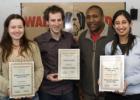It only takes half an hour to save a life
Where you can give blood locally
Give blood at:
Ealing Town Hall
Wed 3rd May (13:45 to 16:15 and 17:00 to 19:15)
Tues 30th May (09:30 to 12:30 and 14:00 to 16:15)
W13 - Sunday 14th May at St John's Ambulance HQ, Loveday Road, 09:30 to 12:30 and 14:00 to 16:15 .

The National Blood Service is a part of the National Health Service, which
collects voluntary donations of blood from the general public. They aim
to encourage existing donors to give three times a year, tempting them
with the free cup of tea and biscuits and the knowledge that they've done
something worthwhile today.
The
UK needs 8,000 units of blood every day to meet the demand of our hospitals.
The increase in our ability to treat patients and the development of new
types of treatment means that the demand for blood keeps on rising. Blood
can also be subdivided into its main components - red cells, white cells,
platelets and plasma - which are used in treating all kinds of conditions,
including leukaemia and anaemia. Unfortunately red cells only last 35
days and platelets are only good for five days. That's why the National
Blood Service needs a continuing supply throughout the year.
Blood comes in four main types - O, A, B and AB. Group O is the most common,
both around the world and in the UK, which means it's in high demand.
The best place to find group O in the UK is in the north of England, while
the South of England has a greater occurance of group A as a result of
European invasions over the centuries. Group B is more commonly found
among the Asian or Chinese communities.
So who can donate blood? Most people between the ages of 17 and 60 can
become a new blood donor, and regular donors who are still in good health
can still donate right up to the age of 70. The National Blood Service
website has a
set of questions to check if you can give blood just now. It's worth
spending a couple of minutes going through them to save yourself a wasted
journey. The website has everything you could possibly want to know, including
a virtual tour showing exactly what happens when you go to donate.
Last year 2.1 million donations were collected from about 1.6 million
donors. It might sound a lot, but it is only 5% of the population, giving
two or three times a year. If you or anyone close to you has ever been
in an accident or needed blood, you'll know how important blood donors
are. It's easy - just type
in your postcode or area to find out when the next local sessions
will be held. It takes less than half an hour, so what's stopping you?
May 5, 2006
Related links
| Related Links | |
|
National Awards for Ward Radio Ealing Hospital's Matron's charter begins to pay off Ealing Hospital to get MRI scanner and new Cardiac Investigation Unit How does your local surgery in Ealing rank? Full Performance Data from the Quality and Outcomes Framework |
|
| Participate | |
Join the Patient and Public Involvement Forum for Ealing PCT or Ealing NHS Trust and contribute to the shape our our local services.
|
